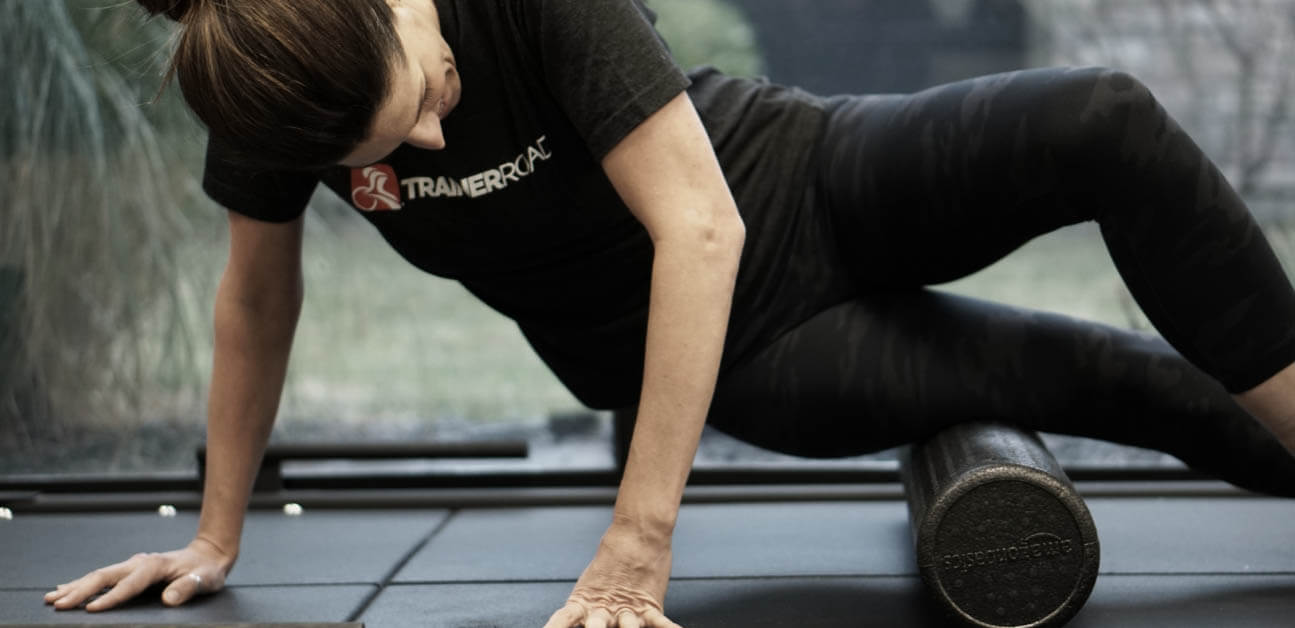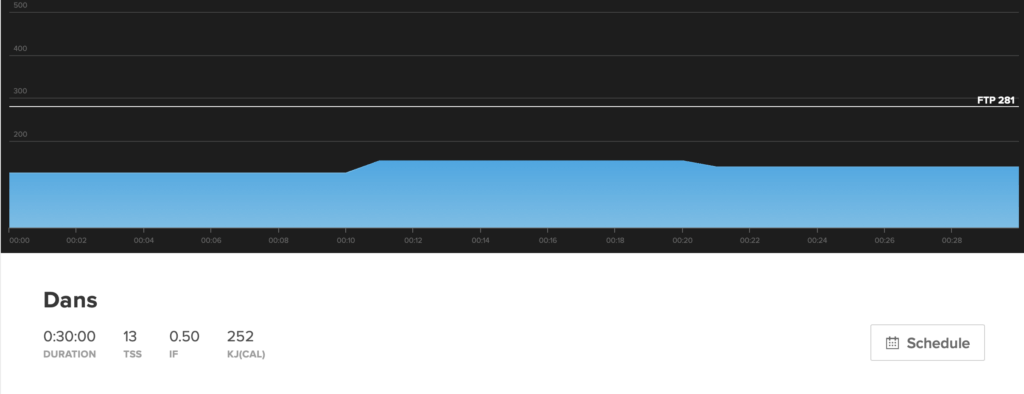Sore Muscles and Cycling: How to Manage DOMS

Dealing with sore muscles is rarely enjoyable, but something athletes manage regularly. As a cyclist, you ask a lot of your body, and the muscles are no exception. But what causes soreness, and what’s the best way to manage it?
For more training and cycling related tips check out Ask a Cycling Coach Podcast Episode 287.
What Is DOMS?
Most athletes have experienced muscle soreness at one time or another. This can be especially true if you are just starting out. DOMS or delayed-onset muscle soreness is a result of exercise-induced muscle damage with symptoms showing up 48-72 hours after exercise. These symptoms can last for several days and up to 5-7.
DOMS is considered a mild form of muscle damage, but one that indicates excess. DOMS is not required for improvement or positive adaptations. The severity of DOMS also depends on several factors. In general, the more unaccustomed stress you place on your muscles, the greater the symptoms. DOMS can occur during any stage of training if it is unfamiliar.
Why Do Muscles Get Sore?
While the exact causes and biological pathways are unknown, it’s generally accepted that DOMS results from microtrauma to individual muscle fibers. This causes an inflammatory response, which includes pain, swelling, stiffness, and joint pain. Within twelve hours of exercise-induced muscle damage (EIMD), your body progressively responds, peaking 48-72 hours later.
Any new activity or unfamiliar stress load can cause EMID. Typically DOMS is associated with beginning strength training, but it can result from any physical activity. That includes any forms in type, intensity, or length of the activity. A fit cyclist can go for a short trail hike, a much longer ride than they’re used to, or try a new cycling discipline and experience sore muscles.
Additionally, DOMS is strongly associated with eccentric muscle contractions. Eccentric contractions occur when the muscle is under tension while lengthening. Lowering the barbell during a bench press is one example. Generally, type II or fast-twitch muscle fibers are more susceptible to DOMS than type I or slow-twitch fibers.
What Muscles Are Sore After Cycling?
Primarily the muscles used for cycling are the ones that can experience DOMS. That would include the quadriceps, glutes, and the posterior chain in the back. However, this is highly dependent on cycling discipline. For example, if you are a road cyclist going on your first MTB ride, you can probably expect to have sore upper body muscles. Again, DOMS will depend on how unaccustomed you are to the activity.
What Helps Sore Muscles From Cycling?
You can do several things to help sore muscles feel better with varying degrees of effectiveness. The only way to completely prevent DOMS is by avoiding unaccustomed exercise altogether, which is difficult for active athletes. However, you can limit DOMS by slowly progressing your training load, especially if you are just starting out. You may find that some treatments work better for you than others, but more than anything, recovery requires time.
Active Recovery
Easy recovery activities increase blood flow to your sore muscles and may provide endorphins that can help relieve the pain associated with DOMS. The research shows mixed results, but active recovery does provide temporary pain relief. This includes light exercise, stretching, and foam rolling.

Dans is an excellent example of an active recovery workout. It’s 30-minutes of riding spent between 45-55% of FTP.
Heat and Cold
Another treatment of DOMS is applying something to sore muscles. The classic ice bath has long been used for DOMS, with the thinking that the cold reduces tissue temperature, causing a redistribution of blood away from the muscle. This can help carry metabolites out of the muscle. However, it may also impair nutrient delivery. Studies show that spending about 13 minutes in water between 52 and 59 degrees can significantly reduce symptoms. Heat therapy can be useful after DOMS has hit its peak. However, if used too soon, applying heat to the muscle can actually increase the inflammatory response.
Compression
There have been several studies regarding the use of compression wear for DOMS. However, the results are mixed, and a conclusion on the timing and duration is far from settled. Compression clothing has been shown to enhance the circulation of damaged muscle tissue, which may affect recovery.
Supplements
A well-balanced diet will give your body the nutrients it needs to repair damaged muscles. Supplementing post-exercise with vitamin D, BCAAs, and antioxidants (like tart cherry juice) offers little to moderate muscle soreness relief. BCAAs are most effective if consumed before a workout with low to moderate muscle damage, while Omega-3 fatty acids (1.8-3 grams) can reduce DOMS when taken after exercise.
For more cycling training knowledge, listen to Ask a Cycling Coach — the only podcast dedicated to making you a faster cyclist. New episodes are released weekly.
References and Further Reading
- Armstrong R. B. (1984). Mechanisms of exercise-induced delayed onset muscular soreness: a brief review. Medicine and science in sports and exercise, 16(6), 529–538.
- Barnett A. (2006). Using recovery modalities between training sessions in elite athletes: does it help?. Sports medicine (Auckland, N.Z.), 36(9), 781–796. https://doi.org/10.2165/00007256-200636090-00005
- Cheung, K., Hume, P., & Maxwell, L. (2003). Delayed onset muscle soreness : treatment strategies and performance factors. Sports medicine (Auckland, N.Z.), 33(2), 145–164. https://doi.org/10.2165/00007256-200333020-00005
- Heiss, R., Hotfiel, T., Kellermann, M., May, M. S., Wuest, W., Janka, R., Nagel, A. M., Uder, M., & Hammon, M. (2018). Effect of Compression Garments on the Development of Edema and Soreness in Delayed-Onset Muscle Soreness (DOMS). Journal of sports science & medicine, 17(3), 392–401.
- Hotfiel, T., Freiwald, J., Hoppe, M. W., Lutter, C., Forst, R., Grim, C., Bloch, W., Hüttel, M., & Heiss, R. (2018). Advances in Delayed-Onset Muscle Soreness (DOMS): Part I: Pathogenesis and Diagnostics. Delayed Onset Muscle Soreness – Teil I: Pathogenese und Diagnostik. Sportverletzung Sportschaden : Organ der Gesellschaft fur Orthopadisch-Traumatologische Sportmedizin, 32(4), 243–250. https://doi.org/10.1055/a-0753-1884
- Hotfiel, T., Freiwald, J., Hoppe, M. W., Lutter, C., Forst, R., Grim, C., Bloch, W., Hüttel, M., & Heiss, R. (2018). Advances in Delayed-Onset Muscle Soreness (DOMS): Part I: Pathogenesis and Diagnostics. Delayed Onset Muscle Soreness – Teil I: Pathogenese und Diagnostik. Sportverletzung Sportschaden : Organ der Gesellschaft fur Orthopadisch-Traumatologische Sportmedizin, 32(4), 243–250. https://doi.org/10.1055/a-0753-1884
- Zainuddin, Z., Newton, M., Sacco, P., & Nosaka, K. (2005). Effects of massage on delayed-onset muscle soreness, swelling, and recovery of muscle function. Journal of athletic training, 40(3), 174–180.